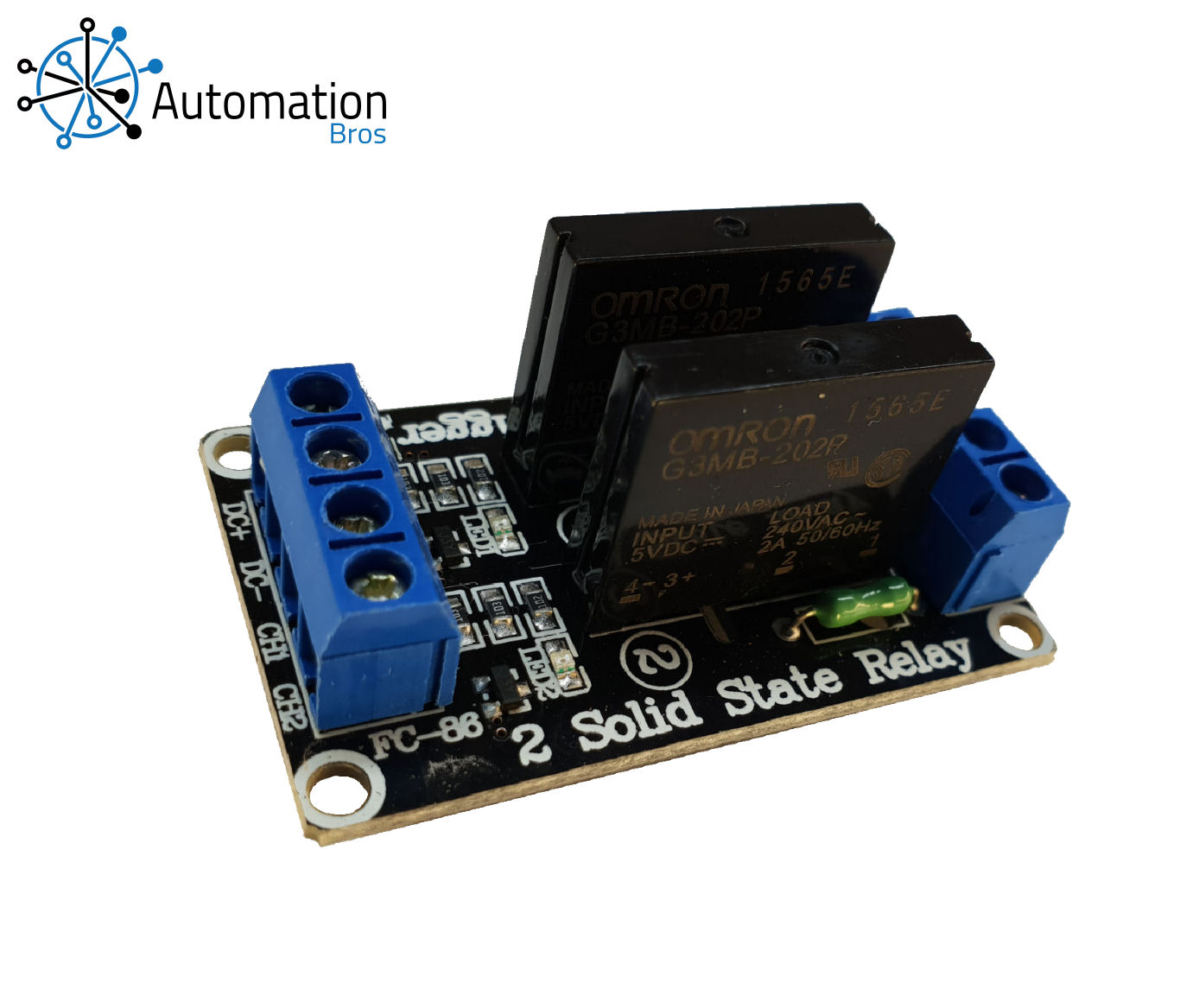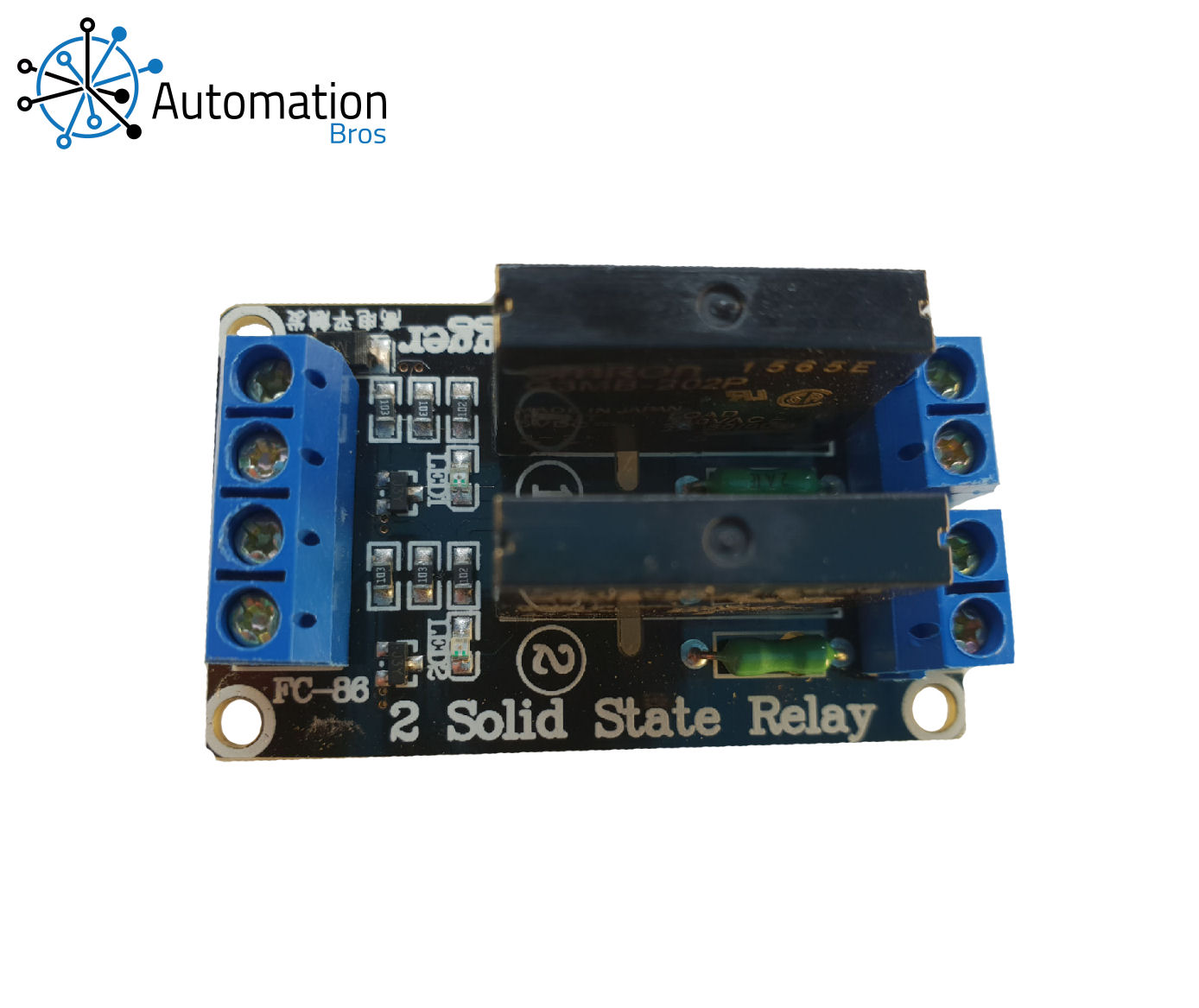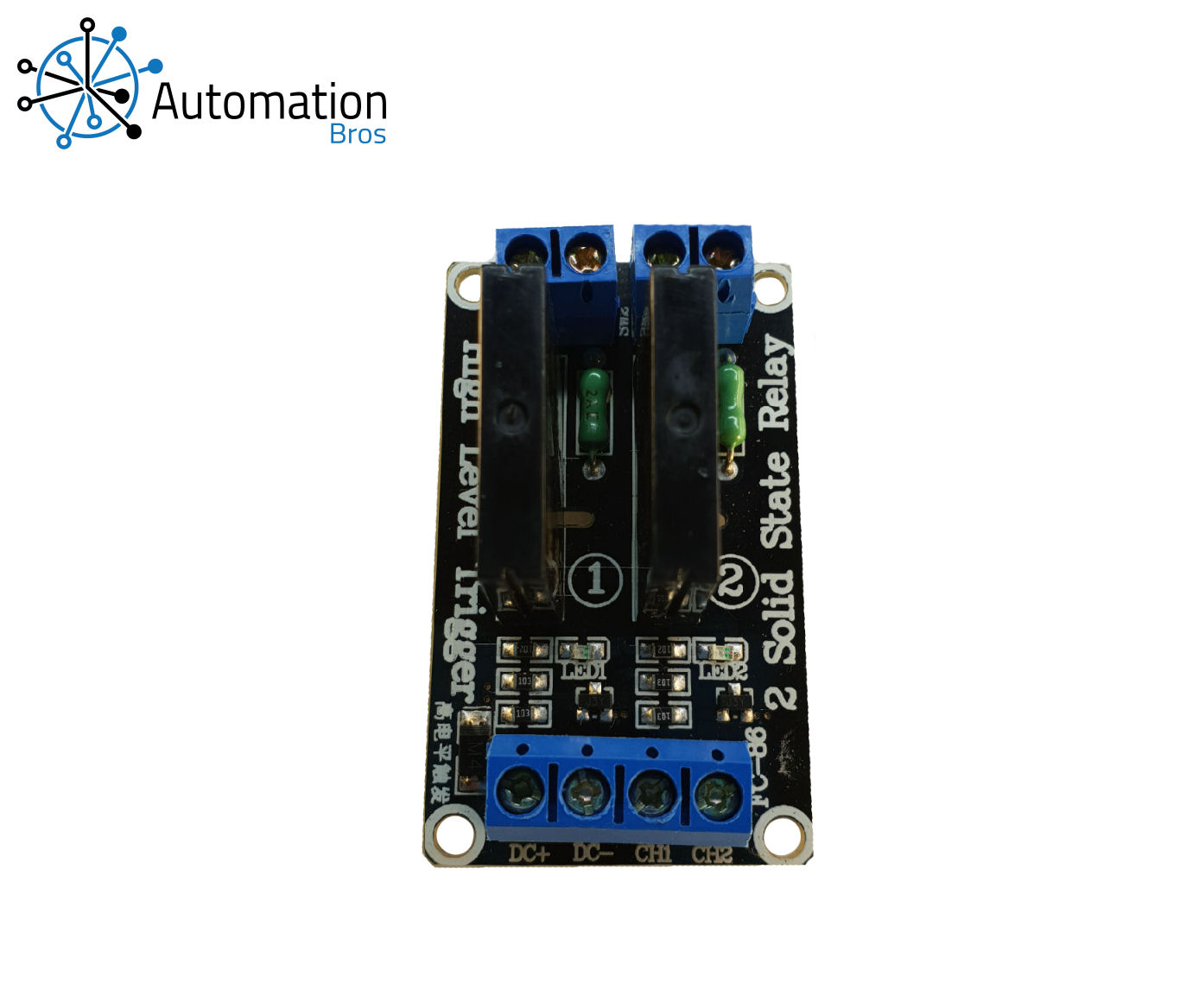Electronic Components
- Home|
- Switch Control|
- Dual AC Solid State Relay
Dual AC Solid State Relay
Active High. This dual channel 3.3 / 5v Solid State Relay module can be used in projects, such as smart home implementation and other automated applications, including switching, Motors, Lamps, Pumps, Roller blinds, etc... OUTPUT: AC voltage 240v 2A max It can be controlled directly with 3.3v or 5v logic signals from a micro-controller or TTL drivers. Inbuilt LED's to indicate an SSR is ON
- Code
- Questions & Answers
- Specifications
basic Arduino Code for Dual SSR Module
FUNCTION: The Arduino LED (connected to pin 13) will flash briefly to indicate SSR 1 is on, at the same time SSR 1 will turn ON. After a brief interval (aproximatley 1/3 second) the led will flash again, at the same time SSR 2 will turn ON. About 1 second later, both SSR's will turn OFF and the cycle will repeat. If you open the Serial Port at 9600 Baud: You will see a text confirmation of when an SSR is ON or OFF You will also see the TX Led flash briefly when the serial lines are sent.
/* BASIC 2 SSR TIMER *************************************************** WIRING: 5v pin on the Arduino to DC+ on the SSR board GND pin on the Arduino to DC- on the SSR board Pin 6 on the Arduino to CH1 on the SSR board Pin 7 on the Arduino to CH2 on the SSR board *************************************************** FUNCTION: The Arduino LED (connected to pin 13) will flash briefly to indicate SSR 1 is on, at the same time SSR 1 will turn ON. After a brief interval (aproximatley 1/3 second) the led will flash again, at the same time SSR 2 will turn ON. About 1 second later, both SSR's will turn OFF and the cycle will repeat. If you open the Serial Port at 9600 Baud: You will see a text confirmation of when an SSR is ON or OFF You will also see the TX Led flash briefly when the serial lines are sent. */ // Declare Pins int firstSSR = 6; int secondSSR = 7; int ledPin = 13; // the setup function runs once when you press reset or power the board void setup() { // Open a Serial port at 9600 Baud Serial.begin(9600); // Initialize digital pins 6, 7, & 13 as outputs. pinMode(firstSSR, OUTPUT); pinMode(secondSSR, OUTPUT); pinMode(ledPin, OUTPUT); } // The loop runs over and over again until the arduino is re-programmed void loop() { digitalWrite(ledPin, HIGH); // The LED is On digitalWrite(firstSSR, HIGH); // Solid State Relay 1 is On Serial.println("SSR 1 is ON"); delay(350); // Led delay digitalWrite(ledPin, LOW); // The LED is Off delay(350); // Led delay digitalWrite(ledPin, HIGH); // The LED is On digitalWrite(secondSSR, HIGH); // Solid State Relay 2 is On Serial.println("SSR 2 is ON"); delay(350); // Led delay digitalWrite(ledPin, LOW); // The LED is Off delay(650); // Relay interval digitalWrite(firstSSR, LOW); // Solid State Relay 1 is Off digitalWrite(secondSSR, LOW); // Solid State Relay 2 is Off Serial.println("Both SSR's are OFF"); Serial.println(""); // Add an empty line delay(1000); // wait for a second }
intermediate Arduino Code for Dual SSR Module
FUNCTION: The Arduino LED (connected to pin 13)will flash briefly when a SSR is ON. Open the Serial monitor (9600 baud) Type 1 to turn SSR 1 ON Type 2 to turn SSR 2 ON Type 0 to turn both SSRs OFF You will see a text confirmation of when an SSR is ON / OFF You will also see the TX Led flash briefly when the serial lines are sent.
/* INTERMEDIATE 2 Channel SSR PROGRAM *************************************************** WIRING: 5v pin on the Arduino to DC+ on the SSR board GND pin on the Arduino to GND on the SSR board Pin 6 on the Arduino to CH1 on the SSR board Pin 7 on the Arduino to CH2 on the SSR board *************************************************** FUNCTION: The Arduino LED (connected to pin 13)will flash briefly when an SSR is ON. Open the Serial monitor (9600 baud) Type 1 to turn SSR 1 ON Type 2 to turn SSR 2 ON Type 0 to turn both SSRs OFF You will see a text confirmation of when an SSR is ON / OFF You will also see the TX Led flash briefly when the serial lines are sent. */ // Declare Pins int firstSSR = 6; int secondSSR = 7; int ledPin = 13; void setup() { // Start Serial at 9600 baud Serial.begin(9600); // Set the relayPin as an OUTPUT pinMode(firstSSR, OUTPUT); pinMode(secondSSR, OUTPUT); pinMode(ledPin, OUTPUT); // Write digital pins 6 and 7 LOW to hold the SSRs off. digitalWrite(firstSSR, LOW); digitalWrite(secondSSR, LOW); // Acknowledge the program Serial.println("PROGRAM READY"); Serial.println(""); // Print a blank line } // The loop runs over and over again until the arduino is re-programmed void loop() { while (Serial.available()) { char inChar = (char)Serial.read(); if (inChar == '1') { digitalWrite(firstSSR, HIGH); // Turn SSR 1 ON digitalWrite(ledPin, HIGH); // The LED is On Serial.println("SSR 1 is ON"); delay(350); // Led delay digitalWrite(ledPin, LOW); // The LED is Off } else if (inChar == '1') { digitalWrite(secondSSR, HIGH); // Turn SSR 2 ON Serial.println("SSR 2 is ON"); digitalWrite(ledPin, HIGH); // The LED is On delay(350); // Led delay digitalWrite(ledPin, LOW); // The LED is Off } else if (inChar == '0') { digitalWrite(firstSSR, LOW); // Turn SSR 1 OFF digitalWrite(secondSSR, LOW); // Turn SSR 2 OFF Serial.println("BothSSR's are OFF"); Serial.println(""); // Print a blank line. } else if (inChar != 1 && inChar != 2 && inChar != 0) { Serial.println ("Command not recognised"); Serial.println(""); // Print a blank line. } } }
Dual AC Solid State Relay
This module is active high. Active HIGH High= On /Greater than 3 volts at the IN pin will turn the SSR ON Low = Off / Less than 1.5 volts at the IN pin will turn the SSR OFF 4 Pins: VCC / GND / CH1 / CH2 (Connection instructions are in the comments at the top of the example code). This Module can be controlled directly with 3.3V or 5V logic signals from a micro-controller or TTL drivers. Input: 3.3 / 5v DC Output: 240v 2Amps max AC








